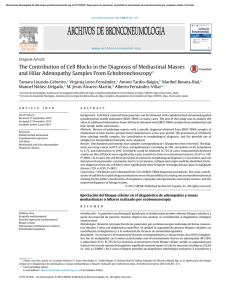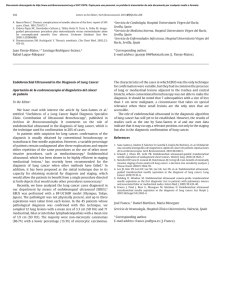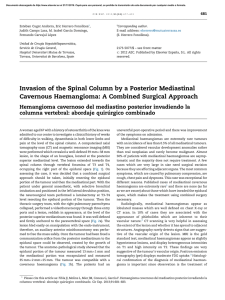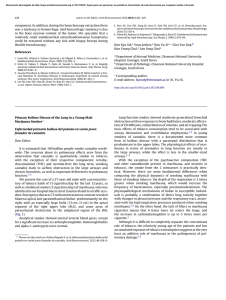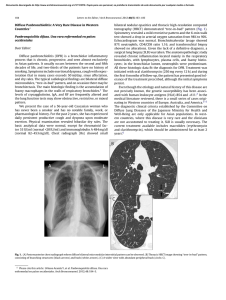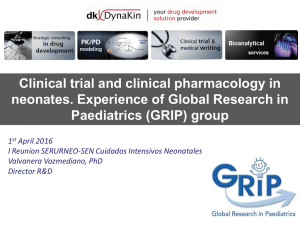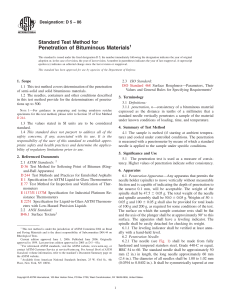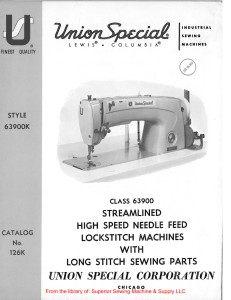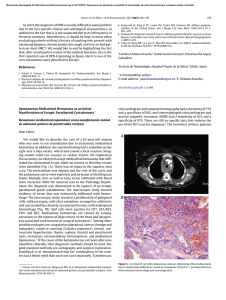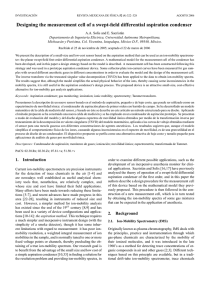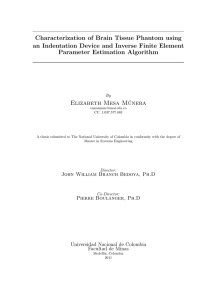overlap for both tests, we cannot conclude that one is better than the
Anuncio
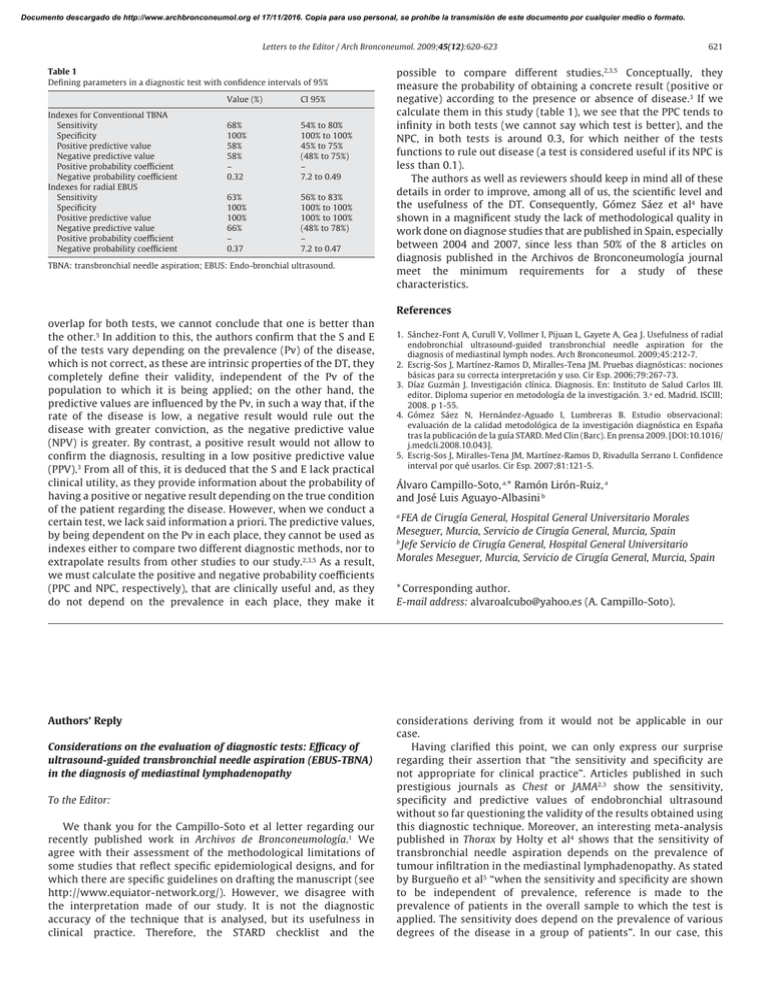
Documento descargado de http://www.archbronconeumol.org el 17/11/2016. Copia para uso personal, se prohíbe la transmisión de este documento por cualquier medio o formato. Letters to the Editor / Arch Bronconeumol. 2009;45(12):620-623 Table 1 Defining parameters in a diagnostic test with confidence intervals of 95% Indexes for Conventional TBNA Sensitivity Specificity Positive predictive value Negative predictive value Positive probability coefficient Negative probability coefficient Indexes for radial EBUS Sensitivity Specificity Positive predictive value Negative predictive value Positive probability coefficient Negative probability coefficient Value (%) CI 95% 68% 100% 58% 58% – 0.32 54% to 80% 100% to 100% 45% to 75% (48% to 75%) – 7.2 to 0.49 63% 100% 100% 66% – 0.37 56% to 83% 100% to 100% 100% to 100% (48% to 78%) – 7.2 to 0.47 TBNA: transbronchial needle aspiration; EBUS: Endo-bronchial ultrasound. 621 possible to compare different studies.2,3,5 Conceptually, they measure the probability of obtaining a concrete result (positive or negative) according to the presence or absence of disease.3 If we calculate them in this study (table 1), we see that the PPC tends to infinity in both tests (we cannot say which test is better), and the NPC, in both tests is around 0.3, for which neither of the tests functions to rule out disease (a test is considered useful if its NPC is less than 0.1). The authors as well as reviewers should keep in mind all of these details in order to improve, among all of us, the scientific level and the usefulness of the DT. Consequently, Gómez Sáez et al4 have shown in a magnificent study the lack of methodological quality in work done on diagnose studies that are published in Spain, especially between 2004 and 2007, since less than 50% of the 8 articles on diagnosis published in the Archivos de Bronconeumología journal meet the minimum requirements for a study of these characteristics. References overlap for both tests, we cannot conclude that one is better than the other.5 In addition to this, the authors confirm that the S and E of the tests vary depending on the prevalence (Pv) of the disease, which is not correct, as these are intrinsic properties of the DT, they completely define their validity, independent of the Pv of the population to which it is being applied; on the other hand, the predictive values are influenced by the Pv, in such a way that, if the rate of the disease is low, a negative result would rule out the disease with greater conviction, as the negative predictive value (NPV) is greater. By contrast, a positive result would not allow to confirm the diagnosis, resulting in a low positive predictive value (PPV).3 From all of this, it is deduced that the S and E lack practical clinical utility, as they provide information about the probability of having a positive or negative result depending on the true condition of the patient regarding the disease. However, when we conduct a certain test, we lack said information a priori. The predictive values, by being dependent on the Pv in each place, they cannot be used as indexes either to compare two different diagnostic methods, nor to extrapolate results from other studies to our study.2,3,5 As a result, we must calculate the positive and negative probability coefficients (PPC and NPC, respectively), that are clinically useful and, as they do not depend on the prevalence in each place, they make it Authors’ Reply Considerations on the evaluation of diagnostic tests: Efficacy of ultrasound-guided transbronchial needle aspiration (EBUS-TBNA) in the diagnosis of mediastinal lymphadenopathy To the Editor: We thank you for the Campillo-Soto et al letter regarding our recently published work in Archivos de Bronconeumología.1 We agree with their assessment of the methodological limitations of some studies that reflect specific epidemiological designs, and for which there are specific guidelines on drafting the manuscript (see http://www.equiator-network.org/). However, we disagree with the interpretation made of our study. It is not the diagnostic accuracy of the technique that is analysed, but its usefulness in clinical practice. Therefore, the STARD checklist and the 1. Sánchez-Font A, Curull V, Vollmer I, Pijuan L, Gayete A, Gea J. Usefulness of radial endobronchial ultrasound-guided transbronchial needle aspiration for the diagnosis of mediastinal lymph nodes. Arch Bronconeumol. 2009;45:212-7. 2. Escrig-Sos J, Martínez-Ramos D, Miralles-Tena JM. Pruebas diagnósticas: nociones básicas para su correcta interpretación y uso. Cir Esp. 2006;79:267-73. 3. Díaz Guzmán J. Investigación clínica. Diagnosis. En: Instituto de Salud Carlos III. editor. Diploma superior en metodología de la investigación. 3.a ed. Madrid. ISCIII; 2008. p 1-55. 4. Gómez Sáez N, Hernández-Aguado I, Lumbreras B. Estudio observacional: evaluación de la calidad metodológica de la investigación diagnóstica en España tras la publicación de la guía STARD. Med Clin (Barc). En prensa 2009. [DOI:10.1016/ j.medcli.2008.10.043]. 5. Escrig-Sos J, Miralles-Tena JM, Martínez-Ramos D, Rivadulla Serrano I. Confidence interval por qué usarlos. Cir Esp. 2007;81:121-5. Álvaro Campillo-Soto, a,* Ramón Lirón-Ruiz, a and José Luis Aguayo-Albasini b FEA de Cirugía General, Hospital General Universitario Morales Meseguer, Murcia, Servicio de Cirugía General, Murcia, Spain b Jefe Servicio de Cirugía General, Hospital General Universitario Morales Meseguer, Murcia, Servicio de Cirugía General, Murcia, Spain a * Corresponding author. E-mail address: [email protected] (A. Campillo-Soto). considerations deriving from it would not be applicable in our case. Having clarified this point, we can only express our surprise regarding their assertion that “the sensitivity and specificity are not appropriate for clinical practice”. Articles published in such prestigious journals as Chest or JAMA2,3 show the sensitivity, specificity and predictive values of endobronchial ultrasound without so far questioning the validity of the results obtained using this diagnostic technique. Moreover, an interesting meta-analysis published in Thorax by Holty et al4 shows that the sensitivity of transbronchial needle aspiration depends on the prevalence of tumour infiltration in the mediastinal lymphadenopathy. As stated by Burgueño et al5 “when the sensitivity and specificity are shown to be independent of prevalence, reference is made to the prevalence of patients in the overall sample to which the test is applied. The sensitivity does depend on the prevalence of various degrees of the disease in a group of patients”. In our case, this Documento descargado de http://www.archbronconeumol.org el 17/11/2016. Copia para uso personal, se prohíbe la transmisión de este documento por cualquier medio o formato. 622 Letters to the Editor / Arch Bronconeumol. 2009;45(12):620-623 refers to the existence of lung cancer. In relation to this, we recommend reading an interesting methodological work by Brenner and Grefeller.6 Finally, as stated by Campillo-Soto et al, the overlap of the confidence intervals does not preclude a statistically significant difference.7 In our study, with a confidence interval of 95%, the performance of the transbronchial needle aspiration in the paratracheal and hilar stations was 19.6 to 48.7% for the conventional needle, and 45.4 to 72.9% for the radial endobronchial ultrasoundguided needle. The difference between these two sets of results is statistically significant. As supported by previous studies in other countries, this implies that the second technique probably has a clinically superior efficacy than the first. 2. Herth FJF, Eberhardt R, Krasnik M, Ernst A. Endobronchial ultrasound guided transbronchial needle aspiration of lymph nodes in the radiologically and PET normal mediastinum in patients with lung cancer. Chest. 2008;133:887-91. 3. Wallace MB, Pascual JMS, Raimondo M, Woodward TA, McComb BL, Crook JE, et al. Minimally invasive endoscopic staging of suspected lung cancer. JAMA. 2008;299:540-6. 4. Holty JE, Kuschner WG, Gould MK. Accuracy of transbronchial needle aspiration for mediastinal staging of non-small cell lung cancer: a meta-analysis. Thorax. 2005;60:949-55. 5. Burgueño MJ, García-Bastos JL, González-Buitrago JM. Las curvas ROC en la evaluación de las pruebas diagnósticas (ROC curves in the evaluation of diagnostic tests). Med Clin (Barc). 1995;104:661-70. 6. Brenner H, Gefeller O. Variation of sensitivity, specificity, likelihood ratios and predictive values with disease prevalence. Stat Med. 1997;16:981-91. 7. Payton ME, Greenstone MH, Schenker N. Overlapping confidence intervals or standard error intervals: what do they mean in terms of statistical significance? J Insect Sci. 2003;3:34. Albert Sánchez-Font, * Víctor Curull and Joaquim Gea References 1. Sánchez-Font A, Curull V, Vollmer I, Pijuan L, Gayete A, Gea J. Utilidad de la punción aspirativa transbronquial guiada con ultrasonografía endobronquial (USEB) radial para el diagnóstico de adenopatías mediastínicas (Usefulness of radial endobronchial ultrasound-guided transbronchial needle aspiration (EBUS-TBNA) for the diagnosis of mediastinal lymphadenopathy). Arch Bronconeumol. 2009;45:212-7. Pulmonary Toxicity due to Methenolone: a Case Report Toxicidad pulmonar por metenolona: a propósito de un caso To the Editor: Drug-induced pulmonary toxicity occurs in between 5 and 30% of patients.1 We describe a case which meets the diagnostic criteria for pulmonary toxicity due to methenolone. A male patient, 26 years old, with no pathological history, a professional bodybuilder who was seen for a 24 h history of grade III progressive dyspnoea and dry cough following self-administration of an initial dose of intramuscular methenolone (300mg). In the physical exam he presented no fever, with normal blood pressure, heart rate and breathing. A continuous vesicular murmur was detected with no pathological sounds. The rest proved normal. Analysis showed 18,200 leukocytes/μl (85% neutrophilis and 0.4% eosinophilis), and the results of the arterial blood gas (inhaled oxygen fraction of 0.21) were as follows: pH at 7.45, carbon dioxide blood pressure of 35mmHg, oxygen blood pressure of 60mmHg and HCO3 of 25mmol/L; the remaining biochemical and coagulation parameters were normal. A simple chest x-ray showed a bilateral alveolointerstitial nodular pattern, Antibiotic treatment was implemented with levofloxacin and the methenolone was discontinued. The CT scan carried out when the patient was admitted showed patches of pneumonitis in ground-glass opacity, predominantly in the upper peripheral regions. The Ziehl-Neelsen stain, Löwenstein-Jensen medium, the Legionella pneumoniae and Streptococcus pneumoniae antigens, as well as the atypical pneumonia serology (Mycoplasma pneumoniae, L. pneumoniae, Coxiella burnetii, Chlamydia pneumoniae and respiratory syncytial virus), all proved negative. The spirometry showed: forced vital capacity (FVC) 4.76 l (79%), Forced expiratory volume in the first second (FEV1) 4.45 l (93%) and FEV1/FVC 93%. The diffusing capacity of the lung for carbon monoxide (DLCO) was 10.17mmol/min/kPa Servei de Pneumologia, Hospital del Mar, IMIM, Universitat Autònoma de Barcelona, Universitat Pompeu Fabra, CIBER de Enfermedades Respiratorias (CibeRes), Barcelona, Spain * Corresponding author. E-mail address: [email protected] (A. Sánchez-Font). (75%), and the corrected value per alveolar volume (DLCO/VA), 1.81mmol/min/kPa/l (86%). 48 h after admission, antibiotic treatment was suspended. The patient’s symptoms improved and an x-ray resolution carried out after seven days, with an oxygen saturation level taken by pulse oximetry (breathing local air) of 97%. After a month, a chest x-ray (fig. 1) continued to show no abnormalities and functional improvement was observed: FVC, 5.45 l (91%), FEV1 5.06 l (106%), FEV1/FVC, 92%. The DLCO was 15.41 mmol/min/kPa (114%) and the DLCO/VA, 2.42mmol/min/kPa/ l (115%). Methenolone is an anabolic hormone used by athletes in order to increase their physical performance. A bibliographic search of MEDLINE (1976-2008) and the Pneumotox2 Web page confirmed that there has been no previous case reported of pulmonary toxicity due to anabolic steroids. It appears that the drugs produce pulmonary lesions through an immunological or cytotoxic mechanism, which may be presented as acute or subacute. Clinical suspicion was established in the face of indicative symptoms in a patient who had taken a harmful drug, together with the radiological3 and functional abnormalities of this type of disease. Functional change is often restrictive, with a low carbon monoxide diffusion capability. Diagnosis is reached through exclusion, aetiological and environmental infections must be ruled out. There is a temporary relationship between taking the drug and the start of the symptoms, which improve once the patient stops taking the drug, and recur if they take it again.4 We believe that this case meets the criteria for considering methenolone as the cause of the lung damage. Although the finding of lymphocytes with an inverse CD4/CD8 ratio in the bronchoalveolar lavage would support the diagnosis,5,6 in our case we did not consider it necessary given the patient’s initial favourable evolution. In regard to the treatment, administering glucocorticosteoroids is not always necessary,6 as occurred in this case, in which a clinical and radiological improvement took place upon discontinuing the drug.
